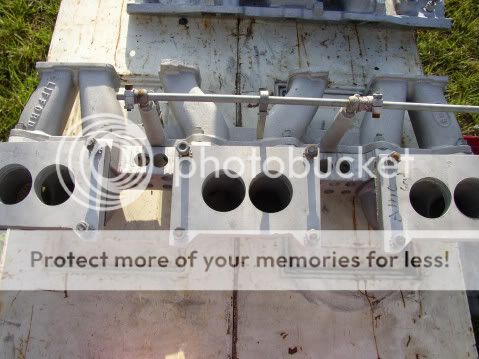Based on a locked off, totally blocked Power Valve on a 2300 series 350 cfm carb with stock Holley venturi.
For cross checking the sizing an IR set-up for a low rpm triple 350 cfm carb set-up, I've used the following Weber call size jets from another website application. Each graph is a generic one for 1.6, 1.9, 2.1, 2.2 and 2.4 liter DOHC Alfa Romeo engines.
Twin DCOE 40 Weber with 28 mm chokes for a 1.6 liter DOHC Alfa Romeo engine= 144 cid Ford Falcon six reving to 5000rpm. 115 micron Weber =152 cc/min=115 microns is a 45.28 thou jet, or close to a 149 cc/min or 44 thou nominal, 44 call size Holley 2300 jet

Twin DCOE 40 Weber with 31 mm chokes for a 1.9 liter DOHC Alfa Romeo engine= 170 cid Ford Falcon six reving to 5000rpm. 125 mircron Weber = 201 cc/min=125 micron is a 49.21 thou jet, or close to a 198 cc/min or 50 thou nominal, 51 call size Holley 2300 jet. Very close is the 205 cc/min or 52 thou nominal, 52 call Holley 2300 jet. Note that Holley also makes some Close Limit jets in the 51 to 52 jet size.

Twin DCOE 40 Weber with 31 mm chokes for a 2.1 liter DOHC Alfa Romeo engine= 188 cid Ford Falcon six reving to 5000rpm. 125 mircron Weber = 201 cc/min=125 micron is a 49.21 thou jet or close to a 198 cc/min or 50 thou nominal, 51 call size Holley 2300 jet
Very close is the 205 cc/min or 52 thou nominal, 52 call Holley 2300 jet. Note that Holley also makes some Close Limit jets in the 51 to 52 jet size.

Twin DCOE 40 Weber with 33 mm chokes for a 2.2 liter DOHC Alfa Romeo engine= 200 cid Ford Falcon six reving to 5000rpm. 135 micron Weber = 251 cc/min=135 microns is 53.15 thou jet or close to a 248 cc/min or 56 thou nominal, 57 call size Holley 2300 jet
.

Twin DCOE 40 Weber with 34 mm chokes for a 2.4 liter DOHC Alfa Romeo engine= 221 cid Ford Falcon six reving to 5000rpm. 140 micron Weber = 275 cc/min=140 microns is 55.12 thou jet, or close to a 267 cc/min or 58 thou nominal, 59 call size Holley 2300 jet jet
 Chart 1:
Chart 2:
The jet sizes for Holley Webers are:-
Chart 1:
Chart 2:
The jet sizes for Holley Webers are:-
103 cc/min=105 microns, or 41.34 thou
128 cc/min=110 microns, or 43.31 thou
152 cc/min=115 microns, or 45.28 thou
178 cc/min=120 microns, or 47.24 thou
201 cc/min=125 microns, or 49.21 thou
225 cc/min=130 microns, or 51.18 thou
251 cc/min=135 microns, or 53.15 thou
275 cc/min=140 microns, or 55.12 thou
298 cc/min=145 microns, or 57.09 thou
325 cc/min=150 microns, or 59.06 thou
346 cc/min=155 microns, or 61.02 thou
375 cc/min=160 microns, or 62.99 thou
400 cc/min=165 microns, or 64.96 thou
425 cc/min=170 microns, or 66.93 thou
450 cc/min=175 microns, or 68.90 thou
475 cc/min=180 microns, or 70.87 thou
525 cc/min=185 microns, or 72.83 thou
Chart 3:
The jet sizes for Holley 2300/4150/4160/4165/4175/4500 carbs are:-
Red indicates the best estimate figures. HolleyWeber and Holley 2300/4150/4160/4165/41754180/4500 jets are not the same, and I've not seen all the data for all jets 40 to 59. Smaller jets have more headloss, and flow much worse than there area would suggest. Those from 60 to 100 are form the
Barry Grant © 1997, catalogue
123 cc/min or 40 thou nominal, 40 call size jet
129 cc/min or 41 thou nominal, 41 call size jet
136 cc/min or 42 thou nominal, 42 call size jet
142 cc/min or 43 thou nominal, 43 call size jet
149 cc/min or 44 thou nominal, 44 call size jet
157 cc/min or 45 thou nominal, 45 call size jet
164 cc/min or 45 thou nominal, 46 call size jet
171 cc/min or 47 thou nominal, 47 call size jet
178 cc/min or 48 thou nominal, 48 call size jet
185 cc/min or 48 thou nominal, 49 call size jet
192 cc/min or 49 thou nominal, 50 call size jet
198 cc/min or 50 thou nominal, 51 call size jet
205 cc/min or 52 thou nominal, 52 call size jet
212 cc/min or 52 thou nominal, 53 call size jet
221 cc/min or 53 thou nominal, 54 call size jet
230 cc/min or 54 thou nominal, 55 call size jet
239 cc/min or 55 thou nominal, 56 call size jet
248 cc/min or 56 thou nominal, 57 call size jet
257 cc/min or 57 thou nominal, 58 call size jet
267 cc/min or 58 thou nominal, 59 call size jet
285 cc/min or 60 thou nominal, 60 call size jet
298 cc/min or 60 thou nominal, 61 call size jet
311 cc/min or 61 thou nominal, 62 call size jet
325 cc/min or 62 thou nominal, 63 call size jet
341 cc/min or 64 thou nominal, 64 call size jet
357 cc/min or 65 thou nominal, 65 call size jet
374 cc/min or 66 thou nominal, 66 call size jet
392 cc/min or 68 thou nominal, 67 call size jet
411 cc/min or 69 thou nominal, 68 call size jet
429 cc/min or 70 thou nominal, 69 call size jet
448 cc/min or 73 thou nominal, 70 call size jet
470 cc/min or 76 thou nominal, 71 call size jet
492 cc/min or 79 thou nominal, 72 call size jet
517 cc/min or 79 thou nominal, 73 call size jet
542 cc/min or 81 thou nominal, 74 call size jet
566 cc/min or 82 thou nominal, 75 call size jet
587 cc/min or 84 thou nominal, 76 call size jet
615 cc/min or 86 thou nominal, 77 call size jet
645 cc/min or 89 thou nominal, 78 call size jet
677 cc/min or 91 thou nominal, 79 call size jet
703 cc/min or 93 thou nominal, 80 call size jet
731 cc/min or 93 thou nominal, 81 call size jet
765 cc/min or 93 thou nominal, 82 call size jet
795 cc/min or 94 thou nominal, 83 call size jet
824 cc/min or 99 thou nominal, 84 call size jet
858 cc/min or 100 thou nominal, 85 call size jet
890 cc/min or 101 thou nominal, 86 call size jet
923 cc/min or 103 thou nominal, 87 call size jet
952 cc/min or 104 thou nominal, 88 call size jet
987 cc/min or 104 thou nominal, 89 call size jet
1014 cc/min or 104 thou nominal, 90 call size jet
1080 cc/min or 105 thou nominal, 91 call size jet
1150 cc/min or 105 thou nominal, 92 call size jet
1200 cc/min or 105 thou nominal, 93 call size jet
1260 cc/min or 108 thou nominal, 94 call size jet
1320 cc/min or 118 thou nominal, 95 call size jet
1375 cc/min or 118 thou nominal, 96 call size jet
1440 cc/min or 125 thou nominal, 97 call size jet
1500 cc/min or 125 thou nominal, 98 call size jet
1570 cc/min or 125 thou nominal, 99 call size jet
1640 cc/min or 128 thou nominal, 100 call size jet








